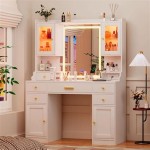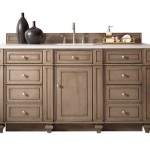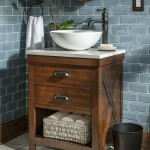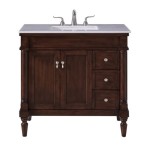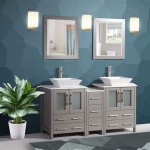Mid Century Modern Bathroom Vanity With Sink: A Timeless Blend of Style and Function
The mid-century modern aesthetic continues to exert a significant influence on interior design, particularly in the realm of bathroom fixtures. A mid-century modern bathroom vanity with sink serves not only as a functional component but also as a statement piece, embodying the clean lines, organic shapes, and a focus on functionality that characterize this enduring design movement. This article will delve into the defining characteristics of these vanities, the materials commonly used in their construction, how to choose the right size and style, and considerations for incorporating them into different bathroom layouts.
Key Characteristics of Mid-Century Modern Bathroom Vanities
Several elements distinguish a mid-century modern bathroom vanity from other styles. Understanding these characteristics is crucial for accurately identifying and selecting a vanity that authentically reflects the design principles of the era.
Clean Lines and Geometric Shapes: One of the most defining features is the emphasis on simplicity and geometric forms. Expect to see rectangular or slightly rounded cabinets with minimal ornamentation. The goal is to create a sleek and uncluttered appearance, reflecting the era's focus on functionality and efficiency. This uncluttered design makes the vanity blend seamlessly into the bathroom while serving its primary function.
Natural Materials: Mid-century modern design heavily incorporates natural materials. Wood, particularly teak, walnut, and oak, is frequently used in the construction of the vanity's cabinet and legs. These woods often showcase a natural grain and warm tones, adding a sense of organic beauty to the bathroom. The use of natural materials also adds longevity to the vanity, making it a worthwhile investment.
Tapered Legs: A signature detail of mid-century modern furniture is the inclusion of tapered legs. These legs, typically made of wood or metal, angle outward from the base of the cabinet, creating a visual lightness and preventing the vanity from appearing bulky. The tapered legs elevate the vanity, allowing for easier cleaning underneath and adding to the overall sense of spaciousness in the bathroom.
Minimalist Hardware: The hardware on mid-century modern vanities is typically understated and functional. Simple pulls or knobs made of brushed metal or wood are common choices. The hardware should complement the overall design without drawing undue attention to itself. The selection of minimalist hardware reflects the era's belief that form should follow function.
Integrated or Vessel Sinks: Sink options often include integrated sinks made of porcelain or composite materials, or alternatively, vessel sinks that sit atop the vanity counter. The sink should maintain the clean lines and simplicity of the overall design. Materials like porcelain or cast iron with a glossy finish are frequently seen, contributing to both the aesthetic appeal and ease of maintenance.
Materials Used in Mid-Century Modern Bathroom Vanities
The materials used in the construction of a mid-century modern bathroom vanity play a significant role in its appearance, durability, and overall aesthetic. An understanding of these materials is essential for making an informed purchase.
Wood: As mentioned previously, wood is a dominant material in mid-century modern design. The common wood types used are:
*Teak: Known for its rich color and exceptional durability, teak is a popular choice. Its natural oils make it resistant to water damage, making it well-suited for bathroom environments.
*Walnut: Walnut offers a darker, more sophisticated look with its deep brown color and distinctive grain patterns.
*Oak: Oak provides a lighter and more versatile option, often finished with a clear coat to showcase its natural grain.
The wood is typically finished with a sealant to protect it from moisture and humidity, common in bathrooms. Proper sealing is crucial for preventing warping and other forms of damage.
Countertop Materials: The countertop material significantly impacts the overall look and functionality of the vanity. Common options include:
*Quartz: A durable and low-maintenance option, quartz is available in a wide range of colors and patterns, including those that mimic natural stone.
*Granite: Although less common than quartz in contemporary mid-century modern interpretations, granite can still be incorporated, particularly if it features a simple, honed finish.
*Solid Surface: Materials like Corian offer seamless integration with the sink and are highly resistant to stains and scratches.
*Laminate: While less expensive, laminate countertops can provide a convincing imitation of wood or stone, offering a budget-friendly option.
The chosen countertop material should be non-porous and resistant to water and cleaning agents.
Metal: Metal is often used for the vanity's legs, hardware, and sometimes as accent detailing. Brushed nickel, stainless steel, and brass are common finishes.
*Brushed Nickel: Offers a subtle, muted shine that complements a variety of wood tones.
*Stainless Steel: Provides a sleek and modern look, often chosen for its durability and resistance to corrosion.
*Brass: Adds a touch of warmth and vintage charm, particularly when used in a subtle, brushed finish.
The metal components should be treated with a protective coating to prevent rust and corrosion, particularly in damp bathroom environments.
Choosing the Right Size and Style for Your Bathroom
Selecting the appropriate size and style of a mid-century modern bathroom vanity requires careful consideration of your bathroom's dimensions, layout, and personal preferences.
Measuring Your Space: Before beginning the search for a vanity, accurately measure the available space in your bathroom. Consider the width, depth, and height of the area where the vanity will be placed. Also, factor in the placement of plumbing fixtures and any obstructions, such as doors or windows. Accurate measurements will prevent the selection of a vanity that is too large or too small for the space.
Single vs. Double Sink: Determine whether you need a single or double sink vanity. A double sink vanity is suitable for larger bathrooms and homes with multiple occupants, offering convenience during busy mornings. However, it requires significantly more space. A single sink vanity is a more practical option for smaller bathrooms or single-person households.
Storage Needs: Assess your storage requirements. Consider the amount of toiletries, towels, and other bathroom essentials that need to be stored. Look for vanities with ample drawer and cabinet space. Some vanities also incorporate open shelving, which can be used for displaying decorative items or storing frequently used items.
Mounting Style: Decide between a floor-mounted or wall-mounted vanity. Floor-mounted vanities offer more stability and are easier to install, as they rest directly on the floor. Wall-mounted vanities, also known as floating vanities, create a more contemporary and spacious look by leaving the floor underneath visible. However, they require a more substantial wall structure for support.
Sink Style: Select a sink style that complements the overall design and functionality of the vanity. Integrated sinks offer a seamless and easy-to-clean surface. Vessel sinks add a unique and stylish touch, but they may require more counter space. Undermount sinks provide a clean and minimalist look, making them easy to wipe down and maintain. The choice of sink style should consider both aesthetics and practicality.
Matching Existing Décor: Consider the existing décor of your bathroom when selecting a vanity. Choose a vanity with a finish and style that complements the color scheme, tile work, and other fixtures in the room. Aim for a cohesive look that reflects the mid-century modern aesthetic. Consider elements like the bathroom's color palette, the type of lighting fixtures, and the style of the mirror to ensure a harmonious design. If your bathroom has existing mid-century modern features, such as patterned tiles or vintage-inspired lighting, selecting a vanity that complements these elements will enhance the overall aesthetic.
By carefully considering these factors, you can select a mid-century modern bathroom vanity that is both functional and visually appealing, enhancing the overall design of your bathroom.

Mid Century Double Bathroom Vanity Acorn Finish West Elm

37 Amazing Mid Century Modern Bathrooms To Soak Your Senses

Mid Century Modern Bathroom Vanity Custom Walnut Freestanding Cabinet Handmade For Remodel Or New Build Etsy

Mid Century Single Bathroom Vanity Acorn Finish West Elm

Mid Century Modern Bath Vanities Walnut And Solid Wood Options The Cabinet

Modern Bathroom Vanities Signature Hardware

Mid Century Brasilia Double Sink Vanity West Coast Modern L A

Li 36 Single Bathroom Vanity In Mid Century Walnut

Mid Century Modern Offset Single Sink What We Make

Celebrating Mid Century Modern Bathroom Vanity Designs Artfasad
